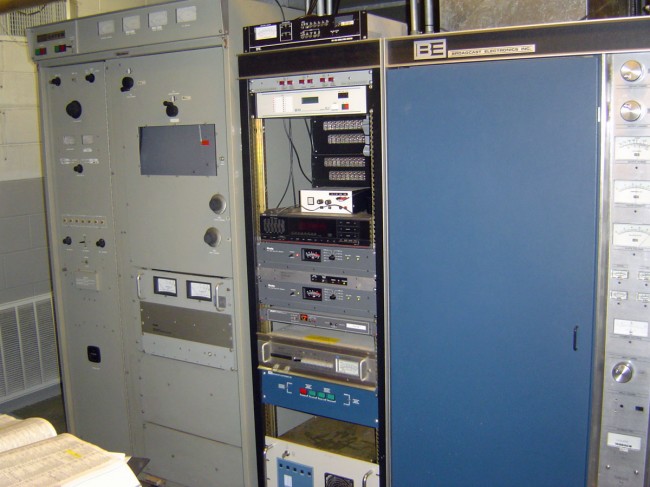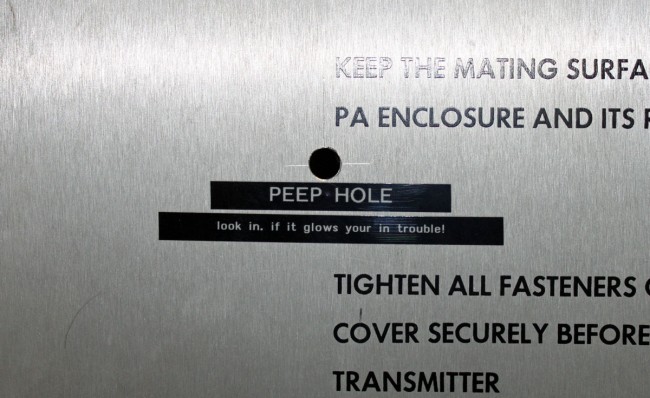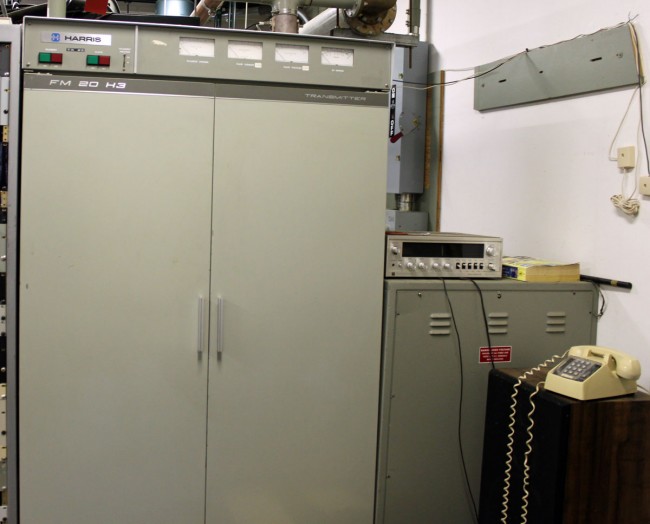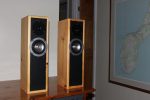We are scrapping several old transmitters these last few weeks as part of a site upgrade A couple of Harris FM20 and 10H transmitters are out the door.

Some people like these transmitters. I am not one of those. I found that they were of dubious reliability, tended to drift out of tune and have AM noise problems, and had multiple catastrophic failure modes. If it was not tuned just right, it also had a tendency to have HF oscillations and internal arcing in the PA cabinet.

This transmitter had a non-factory authorized modification installed as a tuning aid. Tune for best efficiency, and minimum AM noise then check and see if it is arcing. It is also advisable to wear hearing protection during the tuning process.

This particular transmitter was my nemesis for a couple of years. It is actually possible to hate an inanimate object, I can tell you. Goodbye, you piece of shit.
We tend to scrap these instead of dumpster them. It saves the client a little bit of money on dumpster charges. If all the metal is sorted out by category, e.g. all the copper windings are cut from the HV transformer and PS filter inductors, and all the brass, aluminum, and wiring harness are separated, then it is almost worth the time and effort. Personally, I’d rather see all that material reused than landfilled.






Hello !
I think many of the parts could be used as spares for some models still in use or for Ham radio constructions.
Personally I also like very much the old stereo receiver on the last picture, did that went to the “recycle bin” too ?
Thirty-two years ago, my mentor introduced me to the fun side of broadcast engineering with a FM20H3. I spent several hours with a cold chisel carefully opening the PA door, which had spot-welded itself shut.
Pedro, Unfortunately, these transmitters can not be parted out or donated, only disposed of. Those are the rules of the current station owners. The receiver you saw is still at the transmitter site was not a part of the disposal project.
Gregg, I’ll bet that was a fun project.
Paul, might they be available for outright sale (for parts)? I’m in New England, and can pick them up myself. Thanks, Joel
Sorry Joel, can’t do that either, in fact, the transmitter has already been scrapped. If I ever come across anything that can be donated or sold, I will post about it.
Yeah, it was fun. 🙂 Good learning experience…an early lesson on the importance of tight RF connections, even if it was just a cavity door. Also why broadcast engineers have to know a lot more than just soldering. I joke with an IT guy I know that he just has to know IT, while I not only have to know IT, but audio, RF, HVAC, woodworking, metalworking, electrical, plumbing…
Still have an FM 20G and a 20H2 in daily operation. Kaboom!
@ Paul: It was great day when we scrapped the decades old 20H3 on Phoenix and replaced it with a NV-10. Having said, that, it left the pad more or less functional. My local contract guy parted it out for “experiments in high voltage”. Needless to say, I was thrilled and didn’t ask questions. I do remember as a young buck, being near a FM20K when it went off like a shot. Too much circulating current as a result of poor neutralization or such.
Kaboom, indeed! At the same time as my FM20 experiences, I got to take care of two FM2.5’s (one an H3 from 1972, the other a K from 1978). When that 50-ohm (?) resistor in the plate voltage circuit would explode, I would be a nervous wreck for several minutes. I still plug my ears when pressing Plate On buttons because of these things.
Can you say Continental 817A?
817A? Is that the combined 816R’s? I’ve never seen one of those in the field, although I’ve worked on several 816R’s… They can be a little quirky, especially when the SCRs get old and start to leak current before they are turned on. The tube type IPA’s are also a bit troublesome now that 4CX250B’s are not made as well as they used to be. Generally, I have found Continental equipment to be pretty solid, provided it is regularly maintained.
Had many FM-20-H3 and FM-20-K’s over the years and with the exception of the very badly abused and overheated WCGY-FM-20-H3 (the newer FM-20-K was fine)all were very stable and reliable transmitters. Even the WCGY FM-20-H3 with some time and effort (lots of cleaning and cavity parts replacement) came back to full power and reliability until we moved the station down to Peabody with two new Harris HT-30’s. I will say that compared to Continental’s the Harris physical design and implentation left a lot to be desired. The Harris 25 K series was a slight improvement but little things such as the intolerable jet blower noise and the crappy power supply cover screw arrangement (stripped after two or three removals) why did they not use the butterfly fasteners like the RCA’s. and most deficient power supplies in the industry
The 817A was a single-tube 60-kilowatt FM rig (NOT combined 816s). There were only about a dozen of them that were sold, and as far as I know there aren’t any left in the wild…they all went back to Continental. I lived with one for a few years in the late 80s-mid 90s. They were not very well-behaved boxes, and tube life was abysmal.
Our 817A was replaced by a 816R. Night and day difference. Continental did support the thing until the bitter end. Looking at it in a positive way, I did learn a lot about transmitters! The Chief and I spent many Sunday nights wrenching on the thing. Then there was the three tube DTV transmitter, hated to see it go. I figured out how to keep it running and cut down greatly on the middle of the night calls. This stuff can be fun!
Two 817A duds I know of were WBLM and KABL-FM, those transmitters were very uncharacteristic of Continental, maybe more to do with the Eimac tube than the actual transmitter. If I had been it the buying position I’m pretty sure I would have gone with a proven design dual 27.5’s 30’s or 35’s and a combiner, not an unproven 60 KW behemoth with all the eggs in one basket.
WBLM still has a continental but I don’t know if it is the 816R or 817. It is a single cabinet, backup to their main Harris HT/HD 60 (Yes I have it incorrectly marked on my page as a HT/HD 50, I will fix that).
I don’t recall ever seeing inside that transmitter room you have posted here. Is it a station in the Northeast/New York or one of the ones you maintained in Florida?
Mike:
Good eye, I don’t know how you keep all that straight, but the top one you likely have not seen. It is the former WHUD site before the Nautel was installed in 2008. The bottom picture is WYJB as it looked last week. That spot is now a large empty area waiting for a backup transmitter.
The WHUD site now with the four Nautel cabinets is slick. I found that site to be one of the more impressive sites i’ve seen in my travels.
I have a 20H3 as a backup at one place… last time I fired it up into the AUX antenna, it threw lightning out the top of the cabinet! I also had a 3H that got s-canned at another place. That fine specimen is also the reason I flinch and plug my ears when I turn on any tube transmitter. BANG! I HATE these transmitters too. I wouldn’t mind pushing the 20H3 off the Prudential Building (it’s near Boston) and watching it blow apart at the bottom.
Thank goodness I have an FM-20B as a main at that site. Would love a second BE, junk the Gates and rotate between the two mains, but of course that costs money.
I am about to begin a restoration of a FM20H, This unit has a build date of November 1971 and was our original flagship transmitter. It was only removed from service in 2002 now it has to go back in service as a backup. Parts are very hard to find!
Yes, yes, yes…
but were these earth-shattering kabooms?
There was supposed to be an earth-shattering kaboom.
Hey Mathew, when you are done with the FM20H, I have an old AMC Pacer rusting away in the woods behind my house, do you want a crack at that? More seriously, if I come upon any more Harris FM-H series transmitters, I’ll shoot you a line.
Best thing about an old Harris rig is that the cabinet could actually handle lightning,sparking and most anything without setting the room on fire!It could burn a hole in it’ s
self but I could find a a
way to get it back on air the next day.
Few transmitters can claim that in the day.
these days.
Further more,
I really like the concept of our European 5-6 rack unit transmitter,smaller than a 1 KW audio amp and produce 5KW.
It’s all sweet until it breaks down and has to go back to factory for months to be fixed!
These things are hot sandwiches,they just drop dead leaving the station with nothing if they have no alternative means.
They don’t handle American grounding philosophy at higher sites very well.
Paul,what do you say to this?
Discuss.,..
I knew a guy who hade one of these things. He used a pool cue and a pair of noise cancelling headphones to turn plate on. It was quite s site to see the headphones on a hook next to the transmitter.
Harris, oh Harris! Though art the cause of curses flung far and wide. And the cause of engineers high blood pressure and uneaten dinners and lack of sleep. Of arcane and many difficult diagnoses and fixes, wanting to fling her off the roof of the Prudential Building, the ultimate insult that can be hurled at thee. We will miss the infamous sounds of flash, bang, arc, and poof. Goodbye thy piece of junk. To scrap metal you go and your arrival will be celebrated with Champagne toasts. And less of the Burk’s call!
I have enjoyed these tales of old Gates/Harris transmitters! Back in the late ’70s The station I worked with bought a McMartin Transmitter to replace their aging FM 10H. The FM 10H was relegated to backup duty. We were on top on an old iron ore mine and took frequent lightning strikes that wreaked havoc with the new McMartin. No amount of suppression seemed to work so the lightning continued to win the battle (Probably still does. As crappy as that old Gate FM 10H was, I always knew I could get it in the air when the Mac was fried. Something to be said for simplicity! LOL! Thanks again for all the great stories! brings back memories.
Alivehope an NGO is looking for old FM transmitting equipment to start up a community radio station here in Uganda, Africa. My community like any typical African community requires plenty of sensitization on pertinent issues such as health, education , our feeling is to transmit out information to my people on issues affecting them and to raise possible solutions related to this problems, majorly this problems are health, education, income and economics, religious, political empowerment. We would be very glad if any organisation or individuals would be of help, partnerships to this effect are welcome. They say knowledge is power and we strongly believe setting up a radio station in the rural areas would help most of the folks out there have access to information. Our email address is alivehopeministries@gmail.com and our cell number is +256705198926
The arcing is almost always caused by the HV feed-through to the RF enclosure. It must be taken apart and cleaned internally on a regular basis.
I have seen 5 of these units and the very similar FM20H3 in various states, and 3 of them also had the HV input network right next to the feed-through assembled wrong. When this happens, it is no longer a pi-filter for the HV, it is then a spark generator upon start-up! Very easy to do since this area is so hard to reach and see at the same time.
I still have a 1979 FM20K (Much better model than the FM20H3) making daily power, with no back-up. PA and IPA tube life are at about 10months to one year, though, not nearly long enough. Have not been down more than a 12 hour stretch in 10 years.
Back in 1980, while I was CE at KSSN, Little Rock,our main was a 20H. About 2 one Sunday morning, a line of wicked thunderstorms rolled over Chenault Mountain, and we took a direct hit. Two elements of our 8-bay Dual Cycloid were melted, and the PA cavity of the 20H looked like a hand grenade went off in it. The jug was dead, of course, as was the PA bias xfmr. Every bypass cap on the jug socket was shorted, and all the fingerstock had to be replaced. When all the damage was repaired, it still took 90 minutes of careful tuning, and several sets of soiled drawers from arcs before we could make power. We were off for 5 days. Didn’t take much convincing to get the owners to spring for a Continental that fall.
I just found this old, fascinating post. I helped to maintain a couple of FM20Ks on an offshore station. The oldest was a pre-production unit, built without an alarms panel. I don’t recall it being particularly noisy in operation; the extractor directly above it certainly was.
The exciter for the older FM20K was installed in a rack a few yards away. I don’t know why… any ideas? I recall helping TX engineer Dan Smith to tune this rig. I had to crouch by the meter on the exciter and yell directions!
We had some fun with the psu for this exciter. Operation became intermittent; Dan discovered that one of the wires to a power transistor inside had never been soldered, only hooked on. That part was easy, the fun started when we tried to reassemble the thing.
The power transistors were mounted on two lengths of heatsink which stood on end inside the unit. The heatsinks had to be stood exactly in place, inside a bowtie-shaped extrusion in the base of the casing. Then, a similarly-shaped metal ‘lid’ had to be gingerly rested atop the heatsinks’ other ends, without moving them at all. A very long bolt was fed through a hole in the lid and – eventually – through a hole in the base of the unit.
Finally: tighten! Without moving the heatsinks!
I reckon this task took the two of us about 15 minutes of fiddling about and utilising colorful language. What a brilliant design. I’m sure there was a good reason for it.
The old FM20K was eventually joined by a production model, status panel included. Both transmitters provided their fair share of BANGS! and periods of head scratching. In fairness, both were operated in a hot and dirty environment.
And in conjunction with the Harris MPS80, they sounded very good on air.